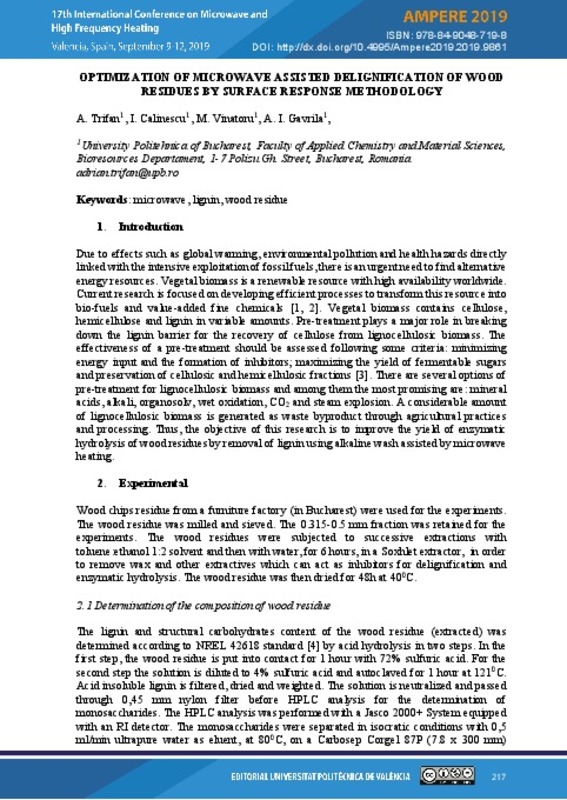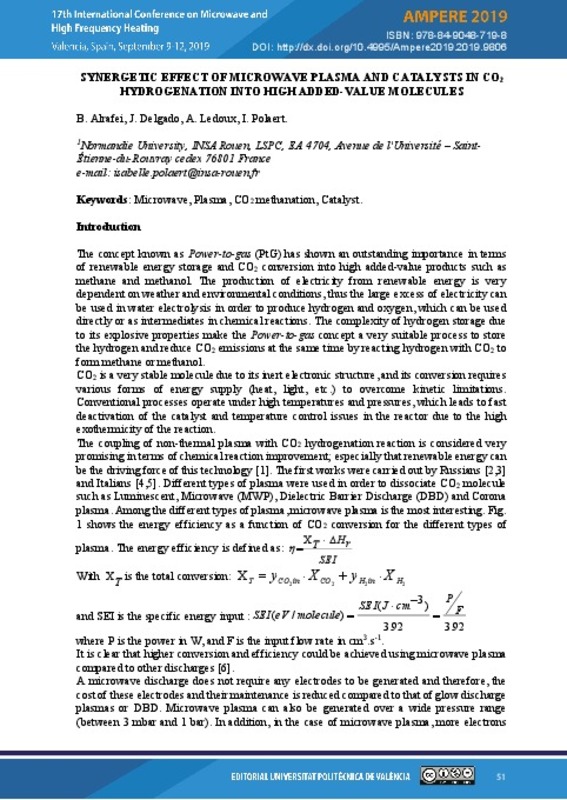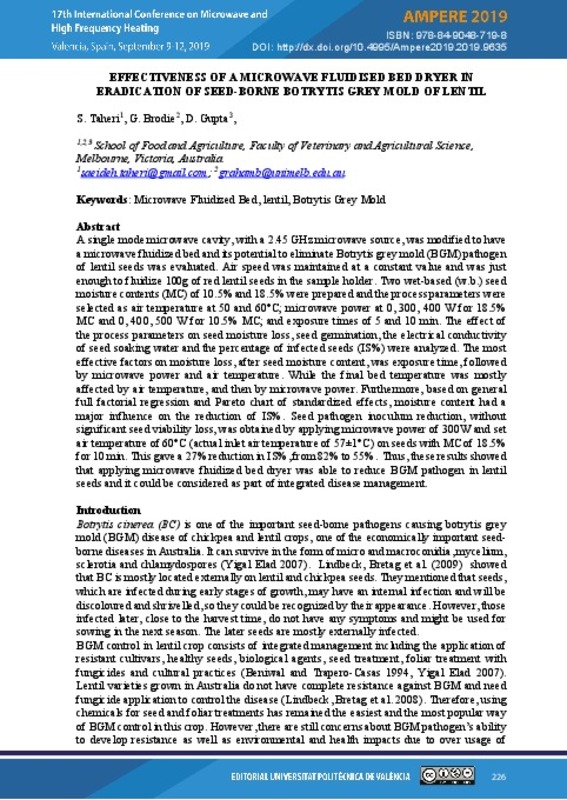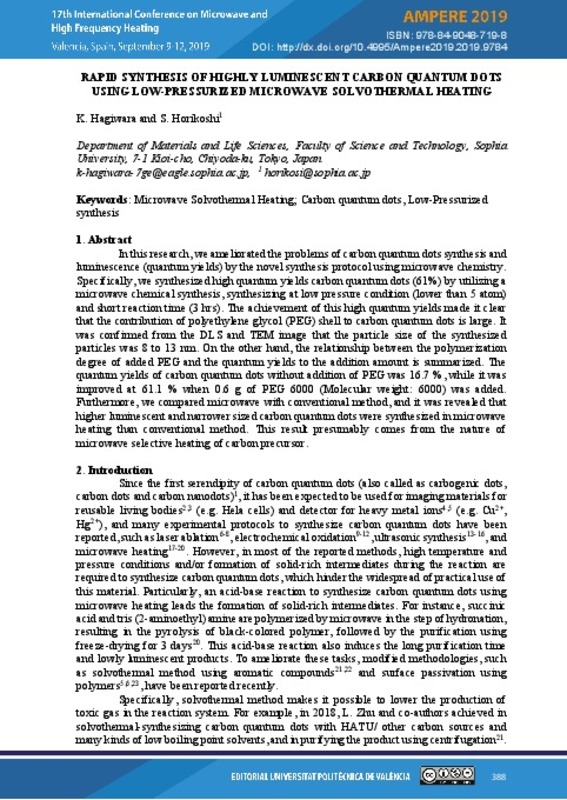JavaScript is disabled for your browser. Some features of this site may not work without it.
Buscar en RiuNet
Listar
Mi cuenta
Estadísticas
Ayuda RiuNet
Admin. UPV
Optimization of microwave assisted delignification of wood residues by surface response methodology
Mostrar el registro sencillo del ítem
Ficheros en el ítem
| dc.contributor.author | Trifan, Adrian
|
es_ES |
| dc.contributor.author | Calinescu, Ioan
|
es_ES |
| dc.contributor.author | Vinatoru, Mircea
|
es_ES |
| dc.contributor.author | Gavrila, Adina
|
es_ES |
| dc.date.accessioned | 2019-11-04T07:43:03Z | |
| dc.date.available | 2019-11-04T07:43:03Z | |
| dc.date.issued | 2019-10-15 | |
| dc.identifier.isbn | 9788490487198 | |
| dc.identifier.uri | http://hdl.handle.net/10251/130158 | |
| dc.description.abstract | [EN] Efficient processing of vegetal biomass is a great challenge to current research studies. This work is focused on improving the yield of enzymatic hydrolysis of wood residues by removal of lignin using a alkaline wash assisted by microwave heating. The treatments were carried out for one hour in a pressurized microwave reactor (Synthwave-Milestone). The performance of the treatments was assessed by monitoring the concentration of lignin (determined by UV absorbance at 320 nm against a calibration curve). Each experiment was carried out in duplicate. The treatment conditions were established according to an experimental matrix constructed (in Design Expert 11) after the careful selection of the most important factors that affect the lignin removal from wood residue: concentration of NaOH solution, liquid to solid ratio and temperature. A central composite design was constructed with the independent factors mentioned above. ANOVA indicated adequate fitting of the model (correlation coefficient R2=0.95). The exploration of the experimental space (figure 1) with the fitted model indicates the dominant effect of temperature as independent factor. Optimization of experimental conditions within the experimental space was carried according to the following criteria: minimization of temperature, liquid to solid ratio and NaOH concentration and maximization of the response variable, the lignin concentration. The optimal solution (141 mg lignin / g dry wood residue) proposed by the model for these optimization criteria indicates a point in the region determined by the following coordinates: 0.4M NaOH, 1070C and a ratio of liquid to solid equal to 50. | es_ES |
| dc.description.sponsorship | The authors acknowledge the financial support received from the Competitiveness Operational Programme 2014 - 2020, Action 1.1.4: Attracting high-level personnel from abroad in order to enhance the RD capacity, ID project: P_37_471, MY SMIS 105145, Ultrasonic/Microwave nonconventional techniques as new tools for nonchemical and chemical processes, financed by contract: 47/05.09.2016. | es_ES |
| dc.format.extent | 8 | es_ES |
| dc.language | Inglés | es_ES |
| dc.publisher | Editorial Universitat Politècnica de València | es_ES |
| dc.relation.ispartof | AMPERE 2019. 17th International Conference on Microwave and High Frequency Heating | es_ES |
| dc.rights | Reconocimiento - No comercial - Sin obra derivada (by-nc-nd) | es_ES |
| dc.subject | Energy Production by Microwaves | es_ES |
| dc.subject | Microwave CVD | es_ES |
| dc.subject | EM Modelling | es_ES |
| dc.subject | Microwave Material interaction | es_ES |
| dc.subject | Dielectric Properties | es_ES |
| dc.subject | Dielectric Properties Measurement | es_ES |
| dc.subject | Solid State Microwave | es_ES |
| dc.subject | Microwave Processing | es_ES |
| dc.subject | Microwave Chemistry | es_ES |
| dc.subject | Microwave applicators design | es_ES |
| dc.subject | Microwave | es_ES |
| dc.subject | Ligning | es_ES |
| dc.subject | Wood residue | es_ES |
| dc.title | Optimization of microwave assisted delignification of wood residues by surface response methodology | es_ES |
| dc.type | Capítulo de libro | es_ES |
| dc.type | Comunicación en congreso | es_ES |
| dc.identifier.doi | 10.4995/AMPERE2019.2019.9861 | |
| dc.relation.projectID | info:eu-repo/grantAgreement/Government of Romania//P_37_471, MY SMIS 105145-47%2F05.09.2016/ | es_ES |
| dc.rights.accessRights | Abierto | es_ES |
| dc.description.bibliographicCitation | Trifan, A.; Calinescu, I.; Vinatoru, M.; Gavrila, A. (2019). Optimization of microwave assisted delignification of wood residues by surface response methodology. En AMPERE 2019. 17th International Conference on Microwave and High Frequency Heating. Editorial Universitat Politècnica de València. 217-224. https://doi.org/10.4995/AMPERE2019.2019.9861 | es_ES |
| dc.description.accrualMethod | OCS | es_ES |
| dc.relation.conferencename | Ampere 2019 | es_ES |
| dc.relation.conferencedate | Septiembre 09-12, 2019 | es_ES |
| dc.relation.conferenceplace | Valencia, Spain | es_ES |
| dc.relation.publisherversion | http://ocs.editorial.upv.es/index.php/AMPERE2019/AMPERE2019/paper/view/9861 | es_ES |
| dc.description.upvformatpinicio | 217 | es_ES |
| dc.description.upvformatpfin | 224 | es_ES |
| dc.type.version | info:eu-repo/semantics/publishedVersion | es_ES |
| dc.relation.pasarela | OCS\9861 | es_ES |
| dc.contributor.funder | European Regional Development Fund | |
| dc.contributor.funder | Government of Romania |
Este ítem aparece en la(s) siguiente(s) colección(ones)
-
Ampere 2019 [66]











